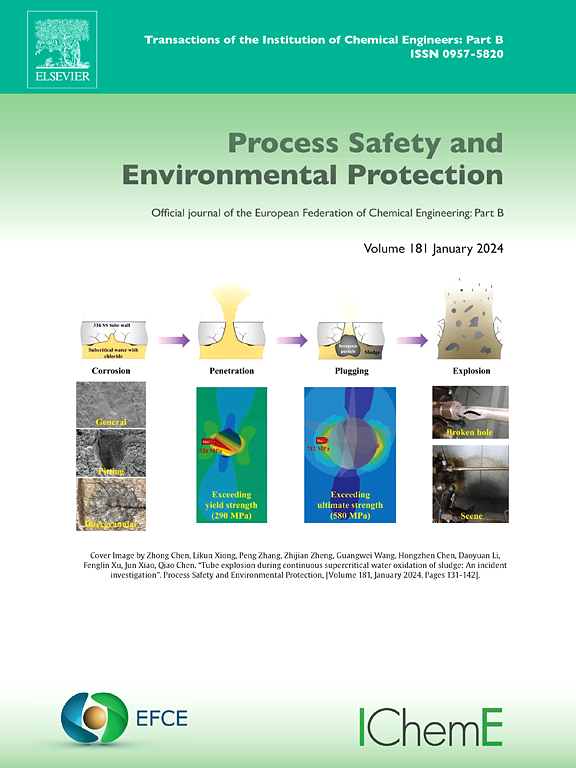Integrated machine learning-based intelligent optimization for clean and efficient operation of diesel engines and diesel particulate filters in dual modes
IF 7.8
2区 环境科学与生态学
Q1 ENGINEERING, CHEMICAL
引用次数: 0
Abstract
To ensure the clean and efficient operation of diesel engines while achieving the safe and effective regeneration of the diesel particulate filter (DPF), an intelligent optimization method is proposed for dual-mode engine operation (normal and regeneration modes). Specifically, an integrated prediction model combining the Extreme Learning Machine (ELM) and Backpropagation Neural Network (BPNN) is developed, while a multi-strategy Salp Swarm Algorithm (MSSA) is introduced to improve model accuracy. By utilizing the MSSA-ELM-BP model combined with the Pareto Envelope-based Selection Algorithm II (PESA-II), a multi-objective optimization method based on multi-model fusion is proposed. This method optimizes both engine emissions and DPF regeneration performance under dual modes. Experimental results from steady-state, transient, and regeneration conditions demonstrate significant performance improvements. In normal mode, NOx emissions were reduced from 886.72 ppm to 829.88 ppm, CO from 113.84 ppm to 90.83 ppm, and smoke opacity from 0.17 FSN to 0.16 FSN under steady conditions. During WHTC testing, emission reductions were evident, with NOx dropping to 392.6 ppm and carbon smoke mass concentration decreasing to 1.03 mg/m³ . In regeneration mode, T4, T5, and O₂ concentrations improved by 6.10 %, 2.90 %, and 18.86 %, respectively, complemented by a 36.40 % increase in T4 temperature, while NOx, CO, HC, smoke, and BSFC decreased by an average of 10.72 %, 4.12 %, 3.24 %, 11.48 %, and 0.24 %, respectively. Additionally, after-optimization regeneration tests confirmed a safe increase in DPF inlet temperature to 560°C and substantial reductions in peak pressure drop and residual smoke levels, demonstrating the effectiveness and safety of the proposed method. This intelligent optimization strategy provides a novel and practical approach to enhancing the clean and efficient operation of diesel engines and aftertreatment systems, contributing to lower emissions, improved fuel efficiency, and sustainable energy utilization.
基于机器学习的柴油发动机和柴油微粒过滤器双模式清洁高效运行集成智能优化
为保证柴油机清洁高效运行,同时实现柴油机微粒过滤器(DPF)安全有效再生,提出了柴油机正常和再生双模式运行的智能优化方法。具体而言,建立了一种结合极限学习机(ELM)和反向传播神经网络(BPNN)的集成预测模型,并引入了多策略Salp Swarm算法(MSSA)来提高模型的精度。将msa - elm - bp模型与Pareto包络选择算法(PESA-II)相结合,提出了一种基于多模型融合的多目标优化方法。该方法在双模式下优化了发动机排放和DPF再生性能。稳态、瞬态和再生条件下的实验结果显示了显著的性能改进。在正常模式下,NOx排放量从886.72 ppm降至829.88 ppm, CO排放量从113.84 ppm降至90.83 ppm,烟气不透明度从0.17 FSN降至0.16 FSN。在WHTC测试期间,减排明显,NOx降至392.6 ppm,碳烟质量浓度降至1.03mg/m³。在再生模式下,T4、T5和O₂浓度分别提高了6.10%、2.90%和18.86%,T4温度提高了36.40%,而NOx、CO、HC、smoke和BSFC分别平均降低了10.72%、4.12%、3.24%、11.48%和0.24%。此外,优化后的再生试验证实,DPF入口温度安全提高到560°C,峰值压降和残余烟雾水平大幅降低,证明了该方法的有效性和安全性。这种智能优化策略为提高柴油发动机和后处理系统的清洁高效运行提供了一种新颖实用的方法,有助于降低排放、提高燃油效率和可持续能源利用。
本文章由计算机程序翻译,如有差异,请以英文原文为准。
求助全文
约1分钟内获得全文
求助全文
来源期刊

Process Safety and Environmental Protection
环境科学-工程:化工
CiteScore
11.40
自引率
15.40%
发文量
929
审稿时长
8.0 months
期刊介绍:
The Process Safety and Environmental Protection (PSEP) journal is a leading international publication that focuses on the publication of high-quality, original research papers in the field of engineering, specifically those related to the safety of industrial processes and environmental protection. The journal encourages submissions that present new developments in safety and environmental aspects, particularly those that show how research findings can be applied in process engineering design and practice.
PSEP is particularly interested in research that brings fresh perspectives to established engineering principles, identifies unsolved problems, or suggests directions for future research. The journal also values contributions that push the boundaries of traditional engineering and welcomes multidisciplinary papers.
PSEP's articles are abstracted and indexed by a range of databases and services, which helps to ensure that the journal's research is accessible and recognized in the academic and professional communities. These databases include ANTE, Chemical Abstracts, Chemical Hazards in Industry, Current Contents, Elsevier Engineering Information database, Pascal Francis, Web of Science, Scopus, Engineering Information Database EnCompass LIT (Elsevier), and INSPEC. This wide coverage facilitates the dissemination of the journal's content to a global audience interested in process safety and environmental engineering.
 求助内容:
求助内容: 应助结果提醒方式:
应助结果提醒方式:


